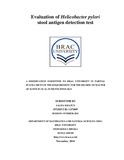Evaluation of helicobacter pyloristool antigen detection test
Abstract
Helicobacter pylori (H. pylori) is a human pathogen causing chronic gastritis, gastric
and duodenal ulcer, gastric carcinoma and dyspepsia. The diagnosis of H. pylori is an
essential element in the management of these gastrointestinal pathologies. There are
several invasive and noninvasive methods for diagnosis of Helicobacter pylori
infection. The plethora of diagnostic tests available for the presence of H. pylori
indicates that none of them is 100% accurate. Invasive methods requiring endoscopic
evaluation include bacteriologic culture, histopathological studies, smear examination,
rapid urease test or CLO test and molecular methods. Noninvasive approaches include
serological testing, stool antigen detection and urea breath testing. The stool antigen
test is convenient, non-invasive, and does not require the use of expensive equipment
or medical personnel. Furthermore, stool can be collected in a patient's home and
transferred to the hospital or laboratory.
The aim of the present study was to evaluate the efficacy of H. pylori stool antigen
detection test (HpSA) in comparison with RUT and serological test.
The present study was carried out on 92 adult patients suffering from dyspepsia and
stool samples were examined from another 31 infants as control. From the patients,
gastric biopsy specimens were taken for detection of H. pylori infection by rapid
urease test (RUT). In addition, stool samples were taken for the detection of H. pylori
antigen and blood samples for detection of anti- H. pylori IgA and IgG antibodies.
Among 92 adult patients undergone endoscopic examination, 19 were found having
ulcer and 73 were found having erosion. Out of 19 ulcer cases, RUT positive cases
were 10 (52.63%) and among 73 erosion cases, 30 (41.09%) cases were RUT
positive. H. pylori infection was detected in total 40 (43.48%) cases by RUT. Among
19 ulcer cases, 14 (73.68%) cases were positive for HpSA and 44 (60.27%) cases
were positive for HpSA out of 73 erosion cases. A total 58 (63.04%) cases were
HpSA positive with a sensitivity and specificity of 100% and 96.77% respectively.
Serum anti H. pylori IgA and IgG antibodies were present in 58 (63.04%) and 89
(96.74%) cases respectively. Both antibodies were present in 57 (61.96%) cases.
Among 40 RUT positive cases, IgG and IgA positive cases were 39 (97.5%) and 26
(65%) respectively and both antibodies were present in 25 (62.5%) cases. IgG and
IgA positive cases were 50 (96.15%) and 32 (61.54%) respectively and both
antibodies were present in 31 (59.62%) cases out of 52 RUT negative patients. Of 40
XIII
RUT positive cases, 39 (97.5%) were stool Ag positive. Among 52 RUT negative
cases, 19 (36.53%) were positive for stool Ag. Among 58 stool Ag positive patients,
57 (98.27%) cases were IgG positive and 39 (67.24%) cases were IgA positive and 38
(65.52%) cases were positive for both antibodies. Out of 34 stool Ag negative cases,
32 (94.11%) and 19 (55.88%) cases were positive for IgG and IgA respectively and
both antibodies were present in 19 (55.88%) cases. Among 31 infants stool samples
examined for H. pylori antigen as control, 30 (96.77%) were negative for stool Ag. In
58 stool Ag positive cases, serum IgG and IgA mean titre were (2.09 ± 0.46) and
(1.40 ± 1.01) respectively. IgG mean titre was 1.94 ± 0.52 and IgA mean tire was 1.23
± 0.95 in 34 stoo Ag negative patients. H. pylori stool antigen assay (HpSA) gave the
highest rate of detection (63.04%), followed by serum antibody detection (61.96 %)
and the lowest by RUT (43.48%).
H. pylori stool antigen assay (HpSA) could be used as a routine diagnostic tool for H.
pylori infection.

